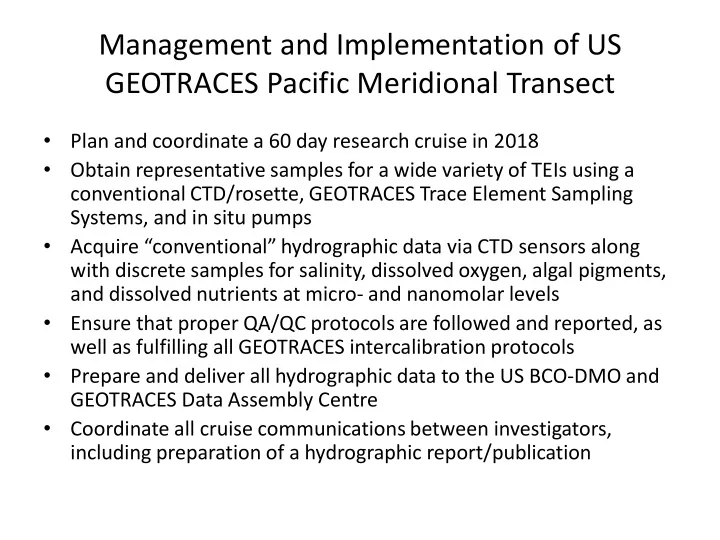

Management and Implementation of US GEOTRACES Pacific Meridional Transect • Plan and coordinate a 60 day research cruise in 2018 • Obtain representative samples for a wide variety of TEIs using a conventional CTD/rosette, GEOTRACES Trace Element Sampling Systems, and in situ pumps • Acquire “conventional” hydrographic data via CTD sensors along with discrete samples for salinity, dissolved oxygen, algal pigments, and dissolved nutrients at micro- and nanomolar levels • Ensure that proper QA/QC protocols are followed and reported, as well as fulfilling all GEOTRACES intercalibration protocols • Prepare and deliver all hydrographic data to the US BCO-DMO and GEOTRACES Data Assembly Centre • Coordinate all cruise communications between investigators, including preparation of a hydrographic report/publication
The overall GEOTRACES Science Driver All of these can be examined on a Pacific Meridional Transect From 52°N to 20°S along 152°W (CLIVAR P16 Line)
Proposed Cruise Track
Interface fluxes: shelf/sediments Horizontal distribution of iron-like tracer concentrations in the northeast subarctic Pacific from an ocean general circulation model at the base of the model mixed layer (40 m). Color bar shows the log10 of tracer concentrations in nM, assuming a 1 µmol/m 2 -d source flux (Lam et al. 2006).
Interface fluxes: Air/sea a) Jickells et al., 2005 (Buck et al., 2013)
Interface fluxes: hydrothermal Depth distributions of d 3 He along the P16 line (figure courtesy of W. Jenkins from data produced at WHOI, LDEO and PMEL).
Interface fluxes + Internal Cycling: OMZs A B A . Distribution of dissolved oxygen on the 26.5 kg/m 3 density surface that is the core of the OMZ originating in the eastern Pacific. B . N* distribution along the 26.5 kg/m 3 density surface
Internal Cycling: Particles and Scavenging Transect of total particle concentration (#/L) for particles with an equivalent spherical diameter between 100µm and 2.5 cm as determined by the Underwater Vision Profiler (UVP) along the 2015 P16N cruise through the Pacific Ocean from Tahiti to the Gulf of Alaska shelf. Note the scale break at 600m between the upper and lower panels. (Data kindly provided by A. McDonnell).
Internal Cycling: Circulation – Equatorial “Layer Cake” SEC SEC NEC SEC SECC NECC EUC NSCC cm/s SSCC EIC Zonal geostrophic flows along the Equator taken between 150-158°W (Wyrtki and Kilonsky 1984). Westward flows are labeled in blue, while eastward are labeled in red.
Internal Cycling: Circulation – intermediate waters A B
Internal Cycling: Circulation – Oldest 14 C deep water Map of circulation 14 C age below 1500 m (taken from Matsumoto, 2007) with the proposed cruise track overlaid.
Some PMT Science Highlights • Oldest 14 C deep waters • Northern section: large nutrient/TEI, freshwater, particle, atmospheric deposition (Asian combustion inputs?), and productivity gradients; sub-Arctic HNLC; N. Pacific intermediate waters; hydrothermal plumes from Loihi and Juan de Fuca; high radiogenic Nd signatures • Equator: upwelling; zonal circulation and TEI transport and signatures; westward extension of OMZ waters; EPR hydrothermal plume • Southern section: EPR hydrothermal plume traced during the EPZT; ultra oligotrophic gyre • And many, many more – THIS MEETING
Cruise Details • 60 days, June-September 2018 window; 20 days transit, 40 days for stations • Ports: Dutch Harbor (AK) and Papeete, Tahiti (ideally in that order, North-South) • 41 vertical profile stations: Test, 17 Full, 5 Super, and 18 Demi. Full and Super stations in deep water – 34 depths (2 overlaps); Demis are 12 depths. Two Crossover Stations for intercalibration with Japanese GP02 and US GP16 • If RV Thompson, 36 berths of which the Management Team uses 15
What Management Grant Supplies • Cutter (chief sci), Casciotti, and Lam • Sampling systems: GEOTRACES clean carousel with 24 12L GO-FLOs; Towed TM-clean, surface sampling fish; ODF rosette with 24 12L Niskins or 12 30L Niskins ; “GEOTRACES” McLane in situ pumps • Two Super Techs each for ODF, GEOTRACES carousel, and McLane systems • ODF team for GO-SHIP/CLIVAR-compliant hydrography and sample salinity, oxygen, and nutrients, data management
What Management Grant Supplies - continued • Nanomolar phosphate, nitrate, and nitrite concentrations when needed, shipboard diss. Zn for contamination checks, algal/HPLC pigments • Data management for all cruise sampling (Event log) and hydrography/nutrients (logging, QA/QC, metadata, submittal) – ODF + Management Team. Advises PIs with their data management • Hydrography report (ODF) and overall cruise report (in collaboration with all PIs) • Coordinates all GEOTRACES Intercalibration activities
What Management Grant Supplies - continued • Overall cruise outreach – early career, freelance, science journalist will be invited on the cruise. Encourage and coordinate cruise blogs. • Cruise meetings/workshops: This proposal planning meeting Pre-cruise logistics meeting Post cruise data synthesis workshop
Recommend
More recommend